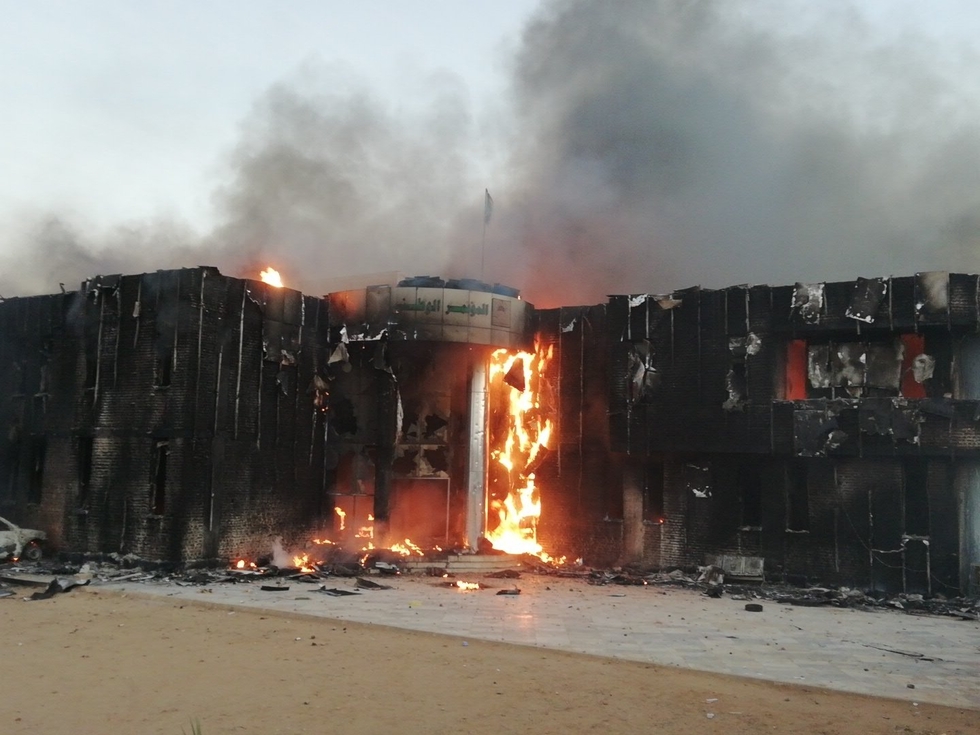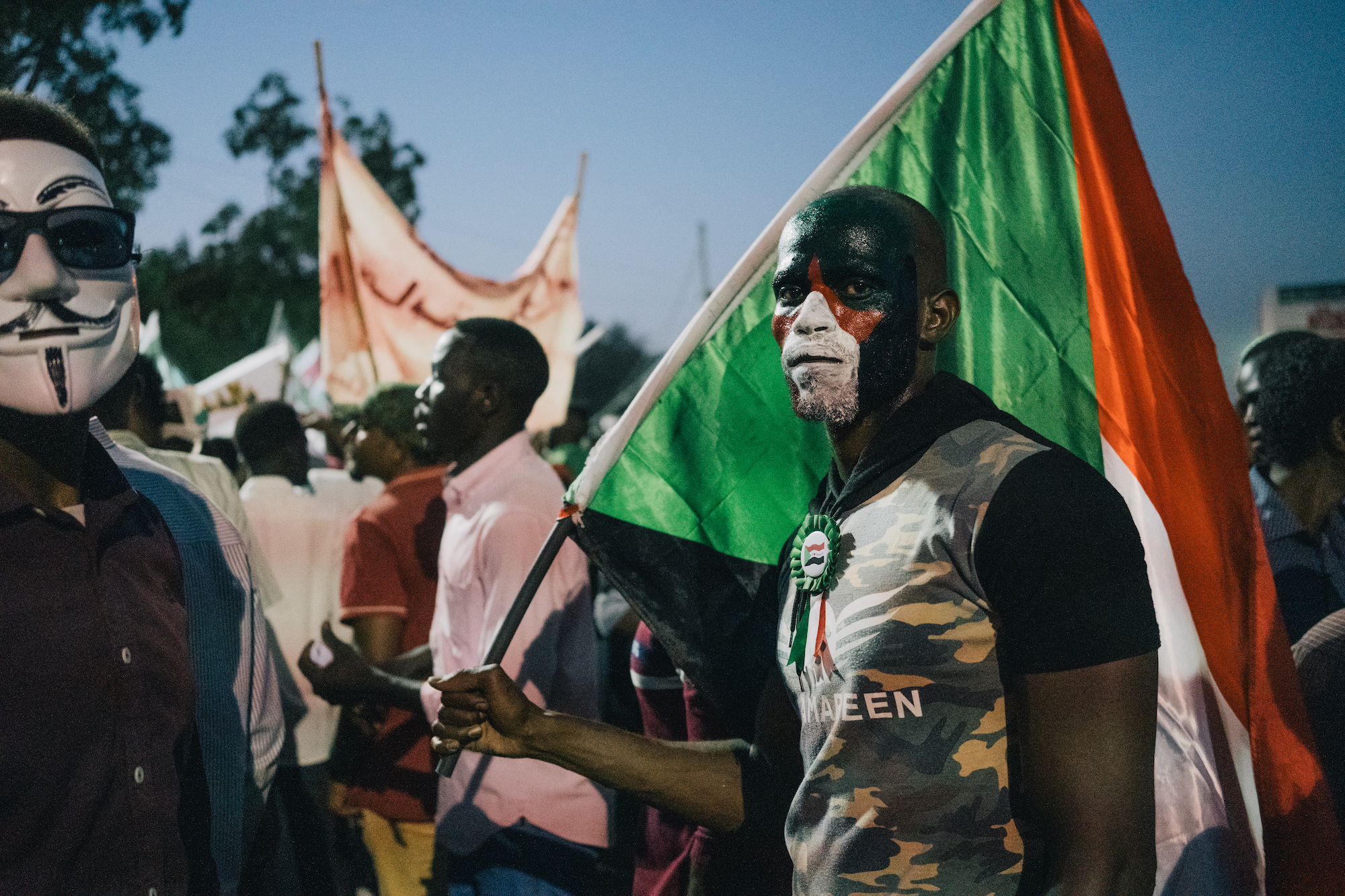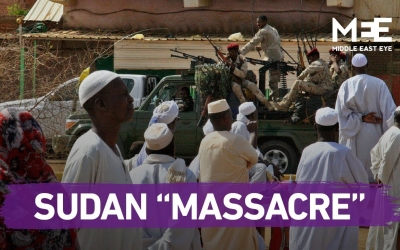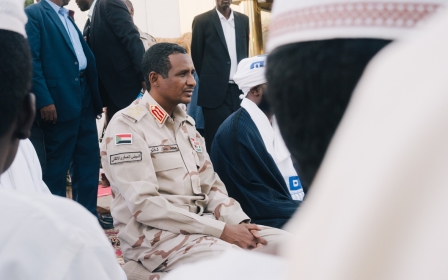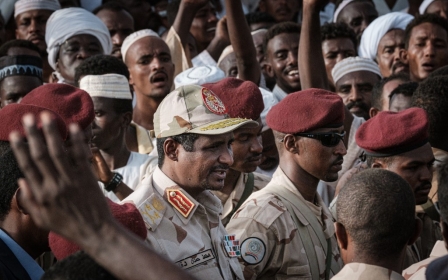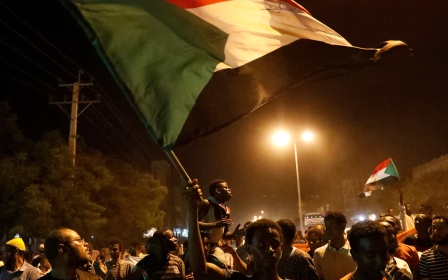Sudan's evolving uprising moves into new stage with 'million-person march'

When two groups of protesting school students came across each other in the Sudanese city of Wad Madani earlier this week, they sprinted towards each other and embraced, then marched in the same direction, in unison.
In the background, the man filming enthusiastically bellowed “civilian [government]!” - the basic demand of Sudan’s protest movement.
It was an image that echoed the early days of Sudan’s revolutionary movement, when city after city exploded in anger at the government, and highlighted the resurgence of those protests only weeks after they were deflated by the Sudanese military dispersing a mass sit-in Khartoum, killing more than 100 people then imposing a crackdown that sent the capital into hiding.
The opposition’s call for a million-person march on Sunday is expected to consolidate this revival in Sudan’s cities and towns, inviting them to congregate in Khartoum in defiance of the ruling military council who replaced three decades of rule by Omar al-Bashir in April.
Stay informed with MEE's newsletters
Sign up to get the latest alerts, insights and analysis, starting with Turkey Unpacked
The protest is expected to be the largest since the 3 June attack on the sit-in, which had lasted almost two months, and marks yet another phase for a movement that has repeatedly adapted to the challenges imposed on it, first by Bashir and then the military council since it began in December.
19 December: Sudan's towns revolt
Bread and fuel were in short supply and their prices were being hiked - the result of austerity measures imposed by Bashir’s government, even while it allocated large chunks of its budget to the military. For weeks, tensions had been bubbling and Sudan’s security forces were dispersing spontaneous protests in Sudanese towns but on 19 December, that anger erupted.
Furious protesters torched the local offices of Bashir’s National Congress Party in Atbara, a city at the heart of Sudan’s railway network with a long legacy of worker activism.
Though rising living costs had tipped the balance, the image of the burning NCP offices sent a decisively anti-government message as it spread rapidly through social media. By the evening, other towns in northern Sudan were joining the protests, inspired by Atbara, and more followed its lead the next day.
Authorities began imposing localised curfews and tethering the internet to limit the spread of images and information.
25 December: Khartoum rallies
After a week when protests had spread through dozens of villages and towns, a group of activists under the umbrella Sudanese Professionals Association emerged as an organising force.
On 25 December it rallied thousands for a march on the presidential palace in Khartoum, where they aimed to deliver a petition calling for Bashir’s resignation.
The response from the security apparatus supporting Bashir was tear gas, rubber bullets and live fire that dispersed the protesters before they could get near their target.
Translation: The scared Omar al-Bashir runs
Bashir himself was out of the city, visiting al-Gezira state to shore up support but ultimately was forced to cancel his speeches as his convoy was jeered by locals.
January to April: Neighbourhood battles
Reversing plans to cancel subsidies on bread prices failed to end enthusiasm for the protest movement, which continued to grow into the new year.
The SPA pushed for Sudanese opposition groups to form a coalition against the government, signing the Declaration of Freedom and Change, which has guided their demands for civilian government.
The government accused students from Darfur, where Bashir is accused of ordering a genocide the UN estimates killed 300,000 people, of fomenting unrest. The response from protesters elsewhere in Sudan was to chant “we are all Darfur”.
Darfur itself joined the provinces protesting while the movement grew stronger in Khartoum, with daily protests in different neighbourhoods of the capital and localised “resistance committees” organising activities aimed to stretch the resources of the Sudanese forces.
Doctors counted that at least 40 people had been killed during the first month of protests but the enthusiasm had not faded. The killing of several protesters in the Burri neighbourhood and attacks on their funerals, attended by thousands, spurred more to attend the daily protests in Khartoum.
The government imposed censorship on newspapers and forces carried out mass arrests of activists, protesters and journalists.
In February, Bashir reshuffled his government, replaced regional governors with military commanders and imposed a state of emergency. The SPA vowed to resist it.
6 April: The sit-in
The anniversary of the last successful Sudanese uprising, which overthrew military ruler Gaafar Nimeiry, turned into an opportunity to consolidate the daily but scattered protests into a mass rally.
The SPA called for a march on the military headquarters in Khartoum and achieved their goal by stretching the police forces with processions that started in various places at different times.
The success of the protest, which saw them occupy the sprawling military zone with a sea of at least tens of thousands of protesters, prompted a decision to stay there, turning the protest into a sit-in.
Over the coming days, the country’s intelligence services and pro-Bashir militias attacked the sit-in on several occasions to disperse it but junior army officers based at the site defended the protesters.
The protesters turned the sit-in into a mass protest site, setting up barricades to protect against attack and putting up tents and stages and providing food and water for the protesters.
11 April: Bashir's exit and negotiations
After months of protest, Bashir was ousted. For a morning, the protesters celebrated their victory in ending 30 years of his rule but the party was cut short when the military leaders who decided Bashir’s time was up announced they were taking control of the country for a “transitional” period.
Protesters immediately returned to the street to demand the military council step aside and by the next day, the man leading the new military council, Awad Ibn Auf, was forced out.
The military council opened negotiations with the SPA and other opposition leaders who signed the Declaration of Freedom and Change. The sit-in remained in place and the SPA organised political and cultural activities to keep it energised while artists turned the walls of military buildings into revolutionary murals.
But every time the talks between the military council and protest leaders appeared to be reaching a crucial point, they faltered over the balance of power between civilians and the military until eventually they stalled altogether. On 28 May, the opposition announced a general strike that paralysed Khartoum and angered the military council.
3 June: The crackdown
On the edges of the protest, Sudanese forces built up their presence through the night and then, at dawn on 3 June, attacked. Led by the notorious Rapid Support Forces paramilitary, military council forces stormed the sit-in and killed at least 100 people, according to doctors. The bodies of victims were thrown into the Nile, women were raped and tents were torched.
The RSF quickly spread throughout Khartoum, breaking down roadblocks created by protesting youth and allegedly harassing and abusing passers-by.
The military council imposed an almost total internet blackout that made organising protests and communication difficult, including getting out evidence of ongoing abuses, but only two weeks after the sit-in was dispersed, protesters were regularly back on the streets of Sudan’s towns.
In its early days, the SPA’s leaders’ names and faces were kept secret to avoid arrest but now they were touring neighbourhoods of Khartoum to deliver in person the messages they could no longer share on the internet.
30 June: The resurgence
To mark the 30th anniversary of the coup that brought Bashir to power, the SPA has called for protesters to gather in Khartoum once again for the largest protest since the sit-in was dispersed.
Described as a memorial for the protesters killed during the movement for a civilian government in Sudan, the protest is being actively promoted by a Sudanese diaspora who have lobbied for international attention and the SPA are calling for a million-person march, despite uncertainties about how the military will react and what comes next.
Middle East Eye delivers independent and unrivalled coverage and analysis of the Middle East, North Africa and beyond. To learn more about republishing this content and the associated fees, please fill out this form. More about MEE can be found here.


